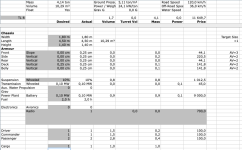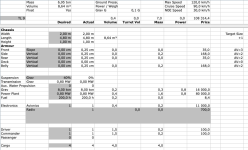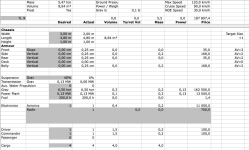Condottiere
SOC-14 5K
For actual vehicular control, one.
I hear that American airlines are lobbying for single pilot passenger planes.
I hear that American airlines are lobbying for single pilot passenger planes.
That is the problem with "under the hood" design systems like Striker, MT or FF&S. They require a great deal of effort and arguably complexity to make them work as intended.Not like Striker isn’t making shit up. One very simple reality check, jet engines per TL, should be doubling of thrust per ton per TL, instead incremental.
In other words, the MgT2 vehicle build.That is the problem with "under the hood" design systems like Striker, MT or FF&S. They require a great deal of effort and arguably complexity to make them work as intended.
I am leaning more to an "work back from the output" design system at least for vehicles recently. Specifically, have a number of templates and make simple modifications for them. Something like this:
Fixed-wing aircraft
Statistics: Displacement 5 (with dissassembled wings), masses 15 metric tons. TL 6-9, MCr 1. Low altitude speed 600 kph, High altitude speed 900 kph. Endurance 6 hours. 2 crew. Payload 6 tons, reduce by 0.25 tons per passenger. Versions not carrying passengers can be reduced to one crew.
Size modifications: Multiply displacement, price and payload by a multiplier up to TL times three. One additional crew possible for every two points of multiplier.
Performance modifications: One free modification per TL above 6. Each additional modification adds +50% price. Options: Increase endurance by 3 hours. Add 300 kph to regular speed. Add 600 kph to burst speed. Add very high altitude capability. Add stealth capability. Add VTOL capability (reduces basic payload by half.)
Added equipment: Sensors, communicators and suitable weapons can be added by adding their price to the total and reducing the payload by their weight. Ordnance and weaponry mounted internally, e.g. in bays, reduces payload by twice its weight. Direct fire weapons must be mounted internally.
It does spaces but is a whole lot more performance stat oriented. For instance, it doesn’t even bother with whether the power plant is IC, fusion, fuel cell, battery etc. You just get x performance at y cost at z TL. You come up with the filler descriptions. Goes real fast.I only know the version from MgT1, which is kinda what I'm going for, but still a bit too reliant on the whole "spaces" thing. (Also, the layout and information density were terrible.) Is the MgT2 one much different?
Your choice.Ok, Air/Rafts, well all grav vehicles one crew station or two? Thinking common aircraft setups...
Basically no go in Striker, the batteries are too bad.Ok, you hooked me, busy trying to figure electric vehicles...
It's limited by both speed and avionics, it's a fraction of max speed up to a maximum set by avionics.Some Notes though, Honestly NOE speed should be based on the Avionics not a fraction of max speed.
Agreed, transmission should be based on actual drive power, not total power.The quick fix is Transmission power should be based on the fraction of power available to the drive systems rather whole power plant output, This is for electric drive vehicles,

Basically no go in Striker, the batteries are too bad.
It's limited by both speed and avionics, it's a fraction of max speed up to a maximum set by avionics.
Yep.Agreed, transmission should be based on actual drive power, not total power.
I kinda liked the final one from MgT1, it was wonky in places but fixable. The one MgT2 has all the wonkiness of the first with more added in. Though if I where to pick I probably got with the CE version of that family of rules.I only know the version from MgT1, which is kinda what I'm going for, but still a bit too reliant on the whole "spaces" thing. (Also, the layout and information density were terrible.) Is the MgT2 one much different?
A trick-use LBB8 robot power and grav for small stuff. Seems to scale better. And making your vehicle robot first and go toy second might make sense for some.Oh, yes. though they were designed to be more capacitor like in use. I.e. temp storage for energy weapon output...
The fraction of max speed doesn't make sense, in that max speed will be the same no matter the altitude. Consider I have personally seen a aircraft break the sound barrier at NOE altitudes. Avionics should be the overall limiter for safe speed in NOE.
Yep.
I started to do your plain vanilla Air/Raft, which looks ok until you get to figuring out power. Geez the grav modules are power hungry where does the 90% waste heat go? Am tempted to cut the power requirement by half at least....
It looks like I will be using sub cubic meter fusion plant. As per the journal article.
FSD Teslas are "non-humanoid robots on wheels" ... so ... seems like a reasonable approach to me.A trick-use LBB8 robot power and grav for small stuff. Seems to scale better. And making your vehicle robot first and go toy second might make sense for some.
Unfortunately self drive robot brains come in at something like Cr10000+, price is ugly.FSD Teslas are "non-humanoid robots on wheels" ... so ... seems like a reasonable approach to me.
Scales the same: Linearly.A trick-use LBB8 robot power and grav for small stuff. Seems to scale better.
Type Thrust Weight Power Thr/Pow Price
UH 50 2 5 10 100k
HV 20 0.6 0.4 50 500k
LT 33.3 0.66 0.33 100 10000k
Striker 50 2 5 10 100kType Volume Weight Power Price
UH 0.4 0.8 2 40k
HV 1 0.6 0.4 500k
LT 0.6 0.4 0.2 6000kHigher power means better agility, i.e. tighter turns, hence higher NOE speed?The fraction of max speed doesn't make sense, in that max speed will be the same no matter the altitude. Consider I have personally seen a aircraft break the sound barrier at NOE altitudes. Avionics should be the overall limiter for safe speed in NOE.
In Striker (which is the CT vehicle design):Higher power means better agility, i.e. tighter turns, hence higher NOE speed?
Yes, we have established that is the rule, now we were discussing how reasonable that is. I think that is theoretically reasonable, but Infojunky disagreed based on his experience?NOE speed is based upon the lower of the Avionics and a multiplier of top speed.
Not just tighter turns, but quicker and more precise vertical conformation with terrain, and better inertial compensation.Higher power means better agility, i.e. tighter turns, hence higher NOE speed?
Sweet spot are those HVs, and don’t forget fuel cell power options.Scales the same: Linearly.
Rescaled to 1 m3 the different LBB8 grav modules give
Code:Type Thrust Weight Power Thr/Pow Price UH 50 2 5 10 100k HV 20 0.6 0.4 50 500k LT 33.3 0.66 0.33 100 10000k Striker 50 2 5 10 100k
LBB8 UH modules are the same as Striker, then you can chose 5 times less power for 5 times the price or 10 times less power for 100 times the price.
You'll save some weight with boutique modules, but it will cost more.
Rescaled to the 20 tonnes of thrust I used in most of my examples:
I would say price is a bit of a problem...Code:Type Volume Weight Power Price UH 0.4 0.8 2 40k HV 1 0.6 0.4 500k LT 0.6 0.4 0.2 6000k
It might possibly be worth it for a speeder or long-range battery powered vehicle?
If we ignore the minimum power plant, we can get:Sweet spot are those HVs, and don’t forget fuel cell power options.


